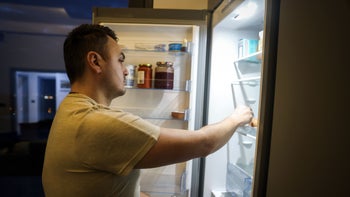
How Long Can Insulin Stay Out of the Fridge?
Key takeaways:
Most insulin manufacturers recommend storing unopened insulin in the fridge. But many insulin products can be unrefrigerated for up to 28 days. There are a few exceptions.
Avoid exposing your insulin to extreme hot or cold temperatures.
Always read the manufacturer’s instructions for storing your particular type of insulin.

If you have diabetes and use insulin to control your blood sugar, you may have noticed that the pharmacy keeps it in the fridge before you pick it up. But should you also keep it in your fridge at home? What about once you open it?
Storing your insulin correctly can be tricky, especially if you use more than one type. Continue reading for more information on how best to store your insulin.
Does insulin need to be refrigerated?
The short answer: Yes. Most manufacturers recommend refrigerating unopened insulin.
Save on popular GLP-1 Agonists
Take control of your health. With GoodRx, you may be eligible to save even more on popular treatments.

Why is that? Insulin is a peptide hormone. Peptide hormones can spoil if not stored properly. All insulins are best kept in the fridge to keep them from spoiling before their expiration date.
What are the general storage recommendations for insulin?
Most insulin manufacturers recommend storing your unused insulin vial or pen in the fridge at temperatures between 36°F and 46°F.
Don’t freeze your insulin or place it near the cooling element in the fridge (the part of the fridge that makes it stay cold). If your insulin freezes, you shouldn’t use it — even after it’s thawed. Once frozen, insulin may not work as well.
Store your insulin away from heat and light for the same reason: heat and light can break insulin down. Don’t store your insulin in your car or in warm areas of your house, like near the stove.
What happens if insulin isn’t refrigerated?
Storing insulin appropriately is important to make sure it’s able to do its job in the body.
Insulin keeps your blood sugar levels from getting too high. So, having enough insulin is important to avoid hyperglycemia (high blood sugar). Early hyperglycemia symptoms can include feeling thirsty, urinating frequently, and blurry vision. More serious symptoms can include confusion, weakness, and shortness of breath.
If insulin isn’t stored correctly, it can spoil and become less effective. If your insulin isn’t effective, you could experience hyperglycemia.
How can I tell if my insulin is spoiled?
Always check the color and consistency of your insulin before you use it. If your insulin is spoiled, it might look different than it normally does. For example, if it’s usually clear but is now cloudy, it may be spoiled.
But, it's not always so obvious. Spoiled insulin may look the same as unspoiled insulin. That’s why it’s important to know how to store your insulin.
Can I use my insulin right out of the fridge?
Yes, you can use your insulin right out of the fridge. But, injecting cold insulin may be uncomfortable and cause local irritation.
Before opening a new insulin vial or pen, you can remove it from the fridge and let it reach room temperature before injecting it. This should help avoid the discomfort from injecting cold insulin.
After the first use of your vial or pen, follow the manufacturer’s instructions for how long you can store your insulin at room temperature. This depends on the type you use.
Do different forms of insulin have unique storage instructions?
Different forms of insulin, and even different brands, may have different storage instructions. Below, we’ll discuss how different forms of insulin are stored. Always read the instructions on your insulin box and ask your pharmacist for specific storage directions.
For reference, refrigerated temperature is 36°F to 46°F and room temperature is 59°F to 77°F or 86°F (depending on the product).
Insulin vials
Unopened insulin vials can be stored in the fridge until their expiration date, and outside the fridge for 28 days. Once opened, most insulin vials last up to 28 days inside or outside the fridge. These include:
Insulin glargine (Lantus)
Insulin lispro (Humalog)
Insulin glulisine (Apidra)
But, some insulins last longer than 28 days outside the fridge. These are listed below.
| Unopened | Opened | ||
| Room Temperature | Refrigerated | Room Temperature | |
| Human insulin (Humulin N) | 31 days | 31 days | 31 days |
| Insulin detemir (Levemir) | 42 days | 42 days | 42 days |
| Insulin degludec (Tresiba) | 56 days | 56 days | 56 days |
Insulin in your insulin pump
The length of time you can keep insulin in your pump depends on the insulin you use. As a general rule, if you expose the insulin in your pump to warm temperatures (higher than 98.6°F), you should replace it.
Pump manufacturers may have different instructions than what your insulin box says, so always check the instructions for your specific pump. If your insulin box and pump instructions are different, follow whichever instructions are stricter (the shortest number of days for changing out insulin). Make sure to also follow your healthcare provider's instructions.
Insulin pens
Unopened insulin pens can be stored in your fridge until their expiration date. Unlike vials, insulin pens shouldn’t be refrigerated once opened.
Most manufacturers recommend keeping your pen outside the fridge and at room temperature once you start using it. When storing insulin pens, make sure the cap is on to protect it from light and remove the needle to prevent air bubbles and contamination.
And you can keep most insulin pens — opened or unopened — outside the fridge for 28 days, the same length as most vials. These include:
Insulin glargine (Lantus Solostar)
Insulin lispro (Humalog Kwikpen)
Insulin glulisine (Apidra Solostar)
Insulin aspart (NovoLog Flexpen; Fiasp FlexTouch)
But there are a few exceptions, shown in the table below:
| Unopened | Opened | |
| Room Temperature | Room Temperature | |
| Humulin N Kwikpen | 14 days | 14 days |
| Insulin glargine 300 units/mL (Toujeo Solostar) | Don’t store at room temperature | 56 days |
| Insulin detemir (Levemir FlexTouch) | 42 days | 42 days |
| Insulin degludec (Tresiba FlexTouch) | 56 days | 56 days |
Insulin mixes
Different insulins are sometimes combined in the same vial or pen. This is called an insulin mix. Unopened insulin mix vials and pens can be kept in the fridge until their expiration date.
With most vials, you can store them for 28 days in the fridge or at room temperature once they’re opened. This includes vials of insulin lispro 75/25 and 50/50 (Humalog 75/25 and Humalog Mix 50/50) and insulin aspart 70/30 (NovoLog Mix 70/30). An exception is 31 days for Humulin 70/30.
For mixed insulin pens, they can’t be stored in the fridge if they’re opened. Once opened, different pens have different storage requirements. See below for examples:
| Unopened | Opened | |
| Room Temperature | Room Temperature | |
| Insulin lispro pen (Humalog Mix 75/25 and Humalog Mix 50/50) | 10 days | 10 days |
| Insulin aspart pen 70/30 (NovoLog Mix 70/30) | 14 days | 14 days |
What if you need to dilute your insulin?
You may need to dilute your insulin if you’re prescribed a very small dose that’s less than half a unit. Only dilute your insulin with the diluent that comes in the box. Always follow the manufacturer’s instructions on how to dilute it.
After diluting insulin aspart (Novolog), you can keep it at room temperature for 28 days. After diluting insulin lispro (Humalog) you can keep it refrigerated for 28 days or at room temperature up to 86°F for 14 days.
Insulin inhalation powder
Afrezza is an inhaled insulin. It comes as a dry powder in a blister pack, wrapped in foil packaging. It should be stored in its original foil package in the fridge until the expiration date written on the box.
Once the foil package is opened, you can keep the unused blister pack in the fridge for up to a month or at room temperature for up to 10 days. Once the blister pack is opened, you should use whatever is left within 3 days.
The bottom line
Insulin is sensitive to extreme temperatures and light. Storing your insulin correctly ensures that it remains effective. If stored incorrectly, it may spoil and become ineffective.
Different insulins have different storage recommendations, and it can get confusing. Always read the manufacturer’s recommendations to check how to store your insulin. If you have any questions about how to store your insulin, talk to your healthcare provider or pharmacist.
Why trust our experts?



References
American Diabetes Association. (2004). Insulin administration. Diabetes Care.
American Diabetes Association. (2021). Insulin storage and syringe safety.
Diabetes Disaster Response Coalition. (2018). Safe storage of insulin.
Eli Lilly. (2020). Humalog 75/25 prescribing information.
Eli Lilly. (2020). Humalog prescribing information.
Eli LIlly. (2020). Humulin 70/30 prescribing information.
Eli Lilly. (2020). Humulin N prescribing information.
Eli Lilly. (2021). Humalog Mix 50/50 prescribing information.
Food and Drug Administration. (2021). Tresiba [prescribing information].
Heinemann L., et al. (2021). Insulin storage: a critical reappraisal. Journal of Diabetes Science and Technology.
Institute for Safe Medicine Practice. (2021). Storage of insulin.
Institute for Safe Medicine Practice. (2021). Insulin pen safety.
Kitabchi A. E., et al. (2001). Management of hyperglycemic crises in patients with diabetes. Diabetes Care.
MannKind. (2021). Afrezza [prescribing information].
Novo Nordisk. (2019). Fiasp [prescribing information].
Novo Nordisk. (2019). Xultophy [prescribing information].
Novo Nordisk. (2021). Levemir [prescribing information].
Novo Nordisk. (2021). Novolog 70/30 [prescribing information].
Novo Nordisk. (2021). Novolog [prescribing information].
Sanofi Pasteur. (2020). Apidra [prescribing information].
Sanofi Pasteur. (2020). Toujeo [prescribing information].
Sanofi Pasteur. (2021). Lantus [prescribing information].
Sanofi Pasteur. (2021). Soliqua [prescribing information].

























